Was Thomas Mair Wrongly Convicted? Part 1.
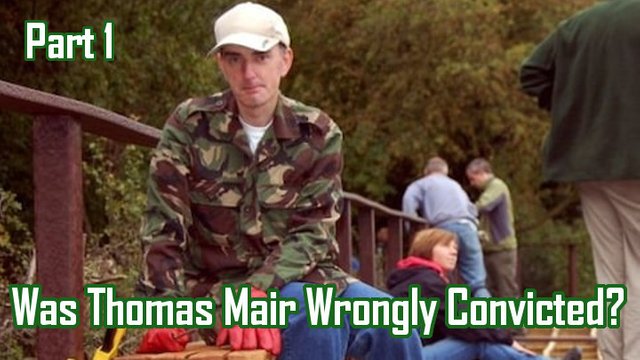
The British state convicted Thomas Mair of the murder of Labour MP Jo Cox at The Old Bailey on 23/11/2016. At the time, many people were uneasy both about the way the case had been handled and the apparent contradictions and gaps in the evidence. However, recent research by the independent investigative journalist and film maker Richard D Hall has cast much firmer doubt upon the safety of Thomas Mair’s conviction.
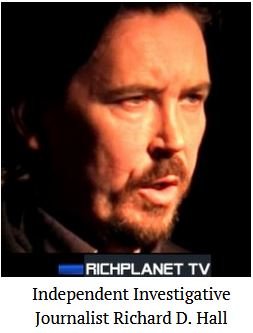
Hall’s film ‘Exit from Bexit: The Jo Cox Departure,’ takes a dispassionate look at the evidence offered by the state to put Thomas Mair behind bars. I recommend that all who care about justice watch his film and consider his arguments.
His work has been met, unsurprisingly, by allegations that he is a supporter of the ‘far right.’ Anyone familiar with Hall’s longstanding commitment to evidence based investigations will know how silly this unsubstantiated slur is. For those who have yet to visit his website or watch his channels, I suggest you do before you believe this preposterous allegation.
Once you’ve considered Hall’s film, and additional evidence offered here, you might ask the same about the ‘far right’ claims heaped upon Thomas Mair. There is absolutely nothing wrong with debating or questioning the evidence he offers. Hall himself always reminds his viewers to “believe none of what you hear and only half of what you see.” He consistently advocates critical thinking and encourages questioning.
So please watch his film and read this post with a critical eye.
The Official Narrative.
Jo Cox was the elected Labour Party MP for Batley and Spen, winning the seat in the 2015 UK general election. On Thursday 16th of June 2016 Cox (41) was due to attend her constituency surgery at the Library in the market town of Birstall, West Yorkshire. She arrived in a silver Vauxhall Astra outside Birstall Library in Market Street at 12.52 (gmt.) Her assistants Sandra Major and Fazila Aswat (driving) were with her. As the three got out of the vehicle a man, said to be Thomas Mair, approached and shot Jo Cox with a home adapted, sawn off .22 calibre, bolt action rifle.
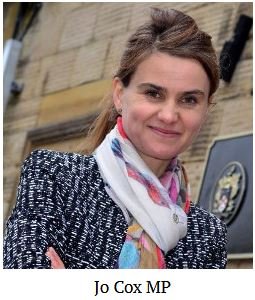
The murder allegedly took place between two parked vehicles. The Silver Astra and a red car parked in front. The man then stabbed Jo Cox multiple times with a large dagger, before stepping back, apparently to reload the rifle, and then stepping forward again to shoot the prone Jo Cox for a second, possibly third time. Despite CCTV coverage outside the Library, no CCTV footage of the murder has been released to the public. Which is understandable.
However, at least 15 witnesses gave statements which were consistent. They each described an older man, with a greying goatee beard, wearing a White baseball cap and dark blue suit/sports jacket carrying out the attack. None of the witnesses knew Thomas Mair and therefore could not positively identify him at the scene.
Sandra Major stated that during the attack Cox shouted to her and Fazila Aswat to “get away……..don’t let him hurt you, let him hurt me.” Astonishing bravery and composure during a frenzied attack. Fazila Aswat stated she urged Jo Cox to think of her two children and get up. According to Aswat, Jo Cox continued her conversation with the two women, during the attack, saying to Aswat “Fazila I can’t move, I’m hurt." Aswat then states that she heard the attacker calmly say “....that’s for Britain First, Britain will always be first, Britain First.”
The man, said to be Thomas Mair, wearing the dark blue suit jacket and white baseball cap, then calmly walked away from the scene of the murder. Many eye witnesses attested to the man's cool, calm and collected manner throughout the attack.
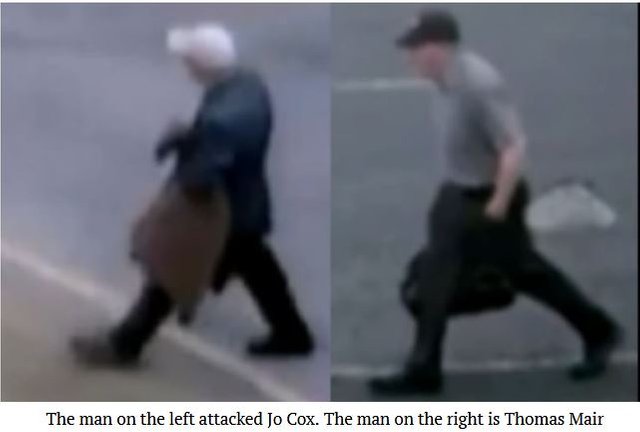
At this point Jo Cox was still alive. According to Jo Cox widow Brendan Cox, Fazila Aswat, rather than call the 999 emergency line for an ambulance, called a police detective Chief Inspector instead. Witnesses said arriving police separated Sandra Major and Fazila Aswat by ushering Major behind a police cordon while allowing Aswat to stay closer to the crime scene.
Contrary to some witness statements, setting the ambulance arrival closer to 13.20, the official narrative records the Ambulance and police arrival at 13.01. Jo Cox was pronounced dead by a doctor, in attendance with paramedics, at the scene, at 13.48. It isn’t clear why Jo Cox wasn’t taken to hospital, approximately 10 minutes away, while she was still alive. Presumably, the nature of her injuries precluded this. There was no other explanation.
The Pursuit & Capture of Thomas Mair.
Hall states that he spoke to two witnesses, named neighbours of Thomas Mair, who stated they saw him leave his home at about 11.40 on the morning of the 16th. Both witnesses stated that Thomas Mair was not wearing a suit/sports jacket when he left his house.
A man wearing a white baseball cap and a dark blue suit/sports jacket, walking with a pigeon toed gait and a noticeable limp, was caught on CCTV in Lowood Lane shortly before the attack. The Police stated this was Thomas Mair.
This same man was captured on numerous CCTV cameras in the town that morning. The man was recorded wearing the blue suit jacket, a white baseball cap, carrying a dark holdall bag. He was captured on CCTV repeatedly crossing Chapel Lane between Birstall market place and the northern end of Market Street. CCTV showed him apparently waiting outside a shop called the Vape Lounge on Market Street, approximately 30 meters from the Library. He was clearly wearing brown shoes and had relatively small feet.
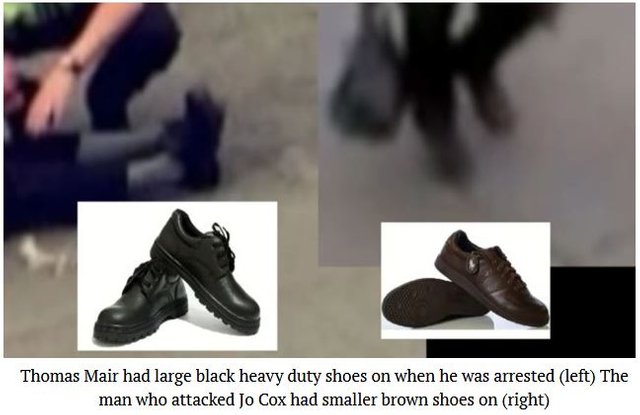
Jo Cox’s car was seen on CCTV entering the southern end of Market street at 12.51. The CCTV footage showing the attack has obviously been withheld by Police. Following the attack, at 12.53, the man with the suit jacket, white baseball cap, small brown shoes and pigeon toed gait, was captured on CCTV limping southwards, along Market street, away from the crime scene.
Not for the first time the man’s route appeared to indicate a lack of local knowledge. He walked to the end of Market Street before turning left into Union Street. Local people, such as Thomas Mair, commonly cut across a supermarket car park to get from Market to Union Street. Given that this was allegedly Thomas Mair, fleeing the scene of a crime, it is difficult to understand why he wouldn’t take the shortest route.
Two witnesses claimed they saw the man proceed along Union Street. They stated that he had a brown coat over one arm which he discarded. Police later located the coat. He then turned left again onto Huddersfield Road. The Police stated that the man, later identified as Thomas Mair, then made his way towards John Nelson Close. There is neither CCTV nor any known witness statements corroborating this claim. There were no witnesses who testified to seeing anyone either entering or leaving the garden during Thomas Mair’s subsequent trial.
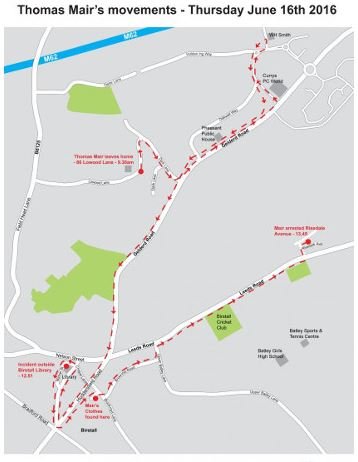
The police stated that, prior to his arrest, Thomas Mair walked to the garden in John Nelson Close where he changed his clothes. They stated, during the course of their investigation, they found the blue suit jacket, white baseball cap and some shell casings in the garden.
A man was clearly seen on CCTV heading onto Hillhead Drive. He was wearing a black baseball cap, grey Tshirt, large black ‘steel toe capped’ gardeners shoes and carrying a similar holdall. He had a long stride and an open, free moving gait and relatively large feet. There was no sign of any pigeon toe or limp. This was the man later arrested by Police, Thomas Mair. Mair did not appear to be the same man seen in the town centre footage, who allegedly killed Jo Cox.
Thomas Mair has a different stride pattern, was wearing different clothes, had larger feet and appeared thicker set than the man seen in the other CCTV images. While the police stated he changed his clothes in John Nelson close, they did not find any shoes and claimed Thomas Mair wore the white cap 'over' the black cap, rather than carry the spare cap in the holdall, or in a pocket.
Hall spoke to a man with family living next door to the John Nelson Close garden. The man told him that none of his family remembered seeing anyone entering or leaving the garden on the 16th. The man also reported that, as far as he knew, no one living in the close saw Thomas Mair that day. The police had remarked to his parents how unusual that was. However, If Thomas Mair wasn't there it would explain the lack of witnesses.
Why Thomas Mair walked to Risedale Avenue, where he was eventually arrested, remains unexplained. Mair lived in Lowood Lane, inaccessible from Risedale Avenue. It made little sense for him to go there after the murder. It is a cul-de-sac, so useless in terms of escape. Thomas Mair neither resisted arrest nor tried to harm himself, so his walk to Risedale Avenue seemed an odd choice for a murderer trying to supposedly evade arrest. If he wasn't trying to get away with the crime why change clothes or attempt to disguise himself?
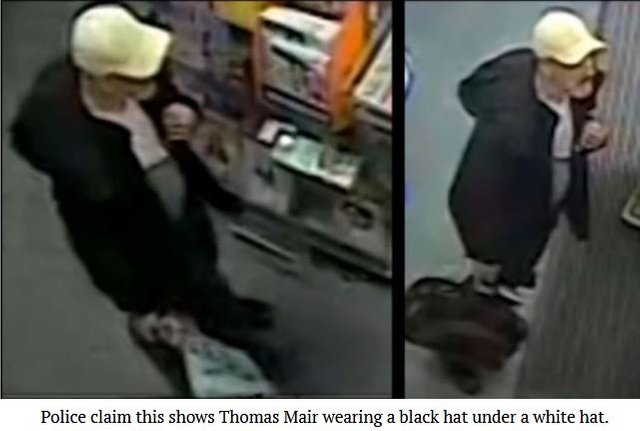
Hall took 17 minutes to walk from Market Street to the scene of Thomas Mair's arrest on Risedale Avenue. Halls route included the detour to John Nelson close and he approximated Thomas Mair's walking pace (as seen on CCTV.) Hall calculated that a brisk walk from John Nelson Close to Risedale Avenue took less than 15 minutes.
Local man Darren Playford (who did not know Thomas Mair) called police stating the killer was following him up Union Street. Mr Playford stated that he had lost sight of the perpetrator as he went behind the Vaults Pub on Huddersfield Rd. Given the CCTV timings, Hall estimated that Playford lost sight of the man wearing the blue jacket and the white baseball cap at 12.57 approximately.
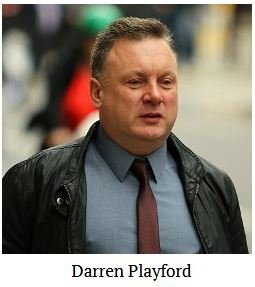
Playford later stated that the man had reappeared, this time wearing a grey T-shirt and black cap. Mr Playford stated that this man, who was later identified as Thomas Mair, was walking up Brownhill Rd (towards Risedale Avenue.)
Hall asks some very important questions about Mr. Playfords alleged sighting. Firstly he suggests it was possible that Playford may have seen two different men of similar physical appearance. One wearing a white the other a black baseball cap. He also noted that Playford was the only witness to Thomas Mair's alleged movements after exiting Union Street. It was Thursday lunch time on a clear day in a busy Market Town, therefore it does seem remarkable that Mr Playford was the only witness to Thomas Mair's movements. Remember, no one saw Thomas Mair in or around John Nelson Close either.
The main problem Hall identifies with Mr Playfords account is the timing. Helicopter camera footage shows that Thomas Mare was arrested by police at just before 13.30. As it takes approximately 15 minutes to walk from John Nelson Close to Risedale Avenue that would mean Thomas Mair allegedly left the Close at 13.15 approximately. However Mr Playford lost sight of the man he was following a couple of minutes before 13.00 (Hall estimates 12.57.) Therefore, Mr Playford must have waited on the call with the police, while Thomas Mair was allegedly in the garden on John Nelson Close, for more than quarter of an hour.
The official account states that Police arrived at Market Street at 13.01, less than a minutes drive from where Mr Playford was on the phone to the them claiming he had sight of the killer. Apparently there was no police response for at least another 25 minutes.
The official timeline states that two patrol officers, PC Nichols and PC Wright, drove past Thomas Mair as he approached White Horse Close at 13.10. They immediately turned the vehicle around and apprehended Thomas Mair in Risedale Avenue. However, the helicopter camera shows the arrest took place just before 13.30. It would have taken no more than a minute for Thomas Mair to walk from where he was first seen by police to the location of his arrest.
Therefore I believe Hall is correct when he states that the official timeline cannot be accurate. Given the location of the initial sighting, Thomas Mair must have first been spotted by police no earlier than 13.25. This timeline is consistent with reports that Mr Playford's call to the police lasted between 14 and 20 minutes.
Witnesses who lived in Risedale Avenue (which is actually a cul-de-sac) stated that the two police officers drove quickly towards Mair. They shouted out to him, he turned, dropped the holdall bag, and the officers got out of the vehicle, rushed towards him and rugby tackled him to the floor. Notably this was the last time that the holdall was in Thomas Mair's possession, he did not touch it again.
During the tackle Thomas Mair banged his head, causing it to bleed. Earlier footage of Thomas Mair showed this was the first time he bled that day. There was no blood visible on Thomas Mair prior to that moment, and no one stated that the man who attacked Jo Cox sustained any injuries during the assault. No DNA evidence at the murder scene identifying Thomas Mair has ever been produced.
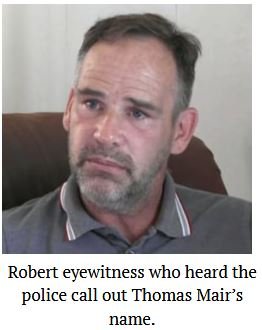
One of the witnesses, Robert, stated that he clearly heard the police say, "are you Thomas Mair, have you just shot and stabbed someone in Market Street?" He mentioned this to his partner at the time, which she corroborated, as he thought it notable that the police already knew Thomas Mair by name. A couple of days later Robert was interviewed by the BBC and told them that the police knew Thomas Mair's name when they apprehended him. This has never been reported by the BBC and neither of these witnesses were invited to give evidence at the subsequent trial.
Thomas Mair lived on the other side of Birstall (Lowood Lane) and no one in Risedale Avenue knew him. However less than three hours after the arrest the BBC broadcast that 'local people' had reported that the suspect was named Tommy Mair. At the time of his arrest, the only people who had apparently identified him were the police. However, the BBC were keen to stress all their information was received from local people, not the police.
There is no doubt the police knew his name. In addition to witness statement given to Hall, video evidence, taken at the time of his arrest, clearly recorded police identifying him by name stating, "...that's Thomas Mair."
The obvious question to ask is how the police knew the name of the man they were looking for? None of the witnesses at the scene of the attack knew who he was. No witnesses at the arrest scene knew him. So how could the Police have possibly known his name less than half an hour after the alleged attack? Why were they looking for Thomas Mair?
The Pre-Trial Destruction Of Thomas Mair.
We were told that Thomas Mair was a far right extremist who believed in the concept of 'white supremacy.' He supposedly killed Jo Cox because she wanted the UK to remain in the EU. The murder of Jo Cox bore a startling similarity to that of Swedish politician Anna Lindh thirteen years earlier. Lindh, just like Cox, was murdered in the run up to an important vote on her nation's relationship with the EU. The political reaction was identical in both cases. Campaigning on the impending referendum was suspended as a mark of respect and there was a poll swing favourable to the EU position. Regardless of the killers intent, just as in the case of Lindh, there was a political impact.
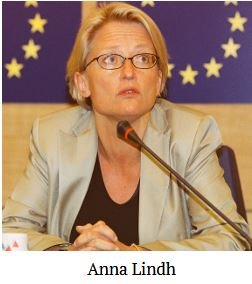
An endless stream of mainstream media (MSM) output castigated Mair as a deranged 'nationalist' extremist in the run up to his trial. There is no possibility at all that the jury were immune from the flood of claims that Thomas Mair was a far right 'terrorist.' For this reason alone, the fairness of Thomas Mair's trial can be questioned. Moreover, there is significant reason to doubt the veracity of these stories.
Not a single person who knew Thomas Mair, including his mixed race brother, with whom he had a good relationship, knew anything about his alleged extremist views. They all described him as a quiet, polite man. An animal lover who cared about his local community and helped others.
He was a keen gardener, often working for free on his older neighbours gardens. He volunteered for local charities and had been interviewed by the local paper for his advocacy of a holistic approach to managing mental health problems. Notably, no one had ever heard Mair express any racist or xenophobic views. In fact, none who knew Thomas Mair had ever heard him express any strong political views at all.
If Thomas Mair was a far right extremist it appears he kept this entirely hidden from everyone who knew him for his whole life. Of course this does not exclude the possibility. Perhaps he is a man with secrets. However, there is evidence that the 'extremism' narrative surrounding Thomas Mair was created before he was said to have murdered Jo Cox.
Just as the police knew he had committed the crime within minutes, so it appears the mainstream media knew Thomas Mair was a far right extremist long before any material evidence emerged at his trial, supposedly corroborating this claim, some 5 months later.
On the day of the murder numerous UK MSM newspapers published stories about Thomas Mair's alleged extremism. Among them was a story published by the Daily Mail entitled, "Revealed: MP's alleged killer 'bought manual on how to make a handgun and bombs from a US far-right group and has links to neo-Nazi organisations going back decades." The stated publication date and time was 23.15 on the day of the attack. A metadata check supports this and confirms the Mail's story was written and published on the 16th.
Thomas Mair's name was first mentioned by the BBC at 16.30 on the 16th. Within 7 hrs, not only had the UK MSM discovered Thomas Mair's alleged links to 'far right' groups but organisations in the United States had already carried out extensive research into his background.
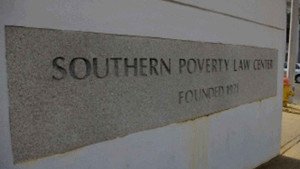
The story in the Mail linked to research published by a so called 'civil rights group,' based in the U.S, called the Southern Poverty Law Center (SPLC.) Again the publication date was 16th June 2018. The SPLC website is published in Montgomery Alabama, which is 6hrs behind UK time (gmt.) Therefore, in order to make publication at 23.15 in the UK, the SPLC must have published their article no later than 17.00 on the 16th (U.S time.)
The first acknowledgment that a man called Thomas Mair was a suspect in the case came via the BBC at 10.30 Alabama time. This meant that the SPLC had just six and a half hours to carry out their extensive research on Thomas Mair, write, publish and distribute the article. Similarly, the Mail immediately picked up this article, verified the contents and published it within a few hours. A truly astonishing piece of collaborative, transatlantic journalism.
For the Mail to have a minimum of an hour to write their story, assuming the SPLC took at least an hour to write theirs, we can reduce the the SPLC's research window to just four and a half hours maximum. What they achieved in those four and a half hours is, frankly, unbelievable.
When Thomas Mair's name was released by the BBC the SPLC knew straight away that they needed to research records they held from a U.S based neo-nazi organisation called the 'National Alliance' (NA.) How they made this connection, before anyone had established any alleged link between Thomas Mair and any 'neo-nazi' groups is baffling. Luckily for the SPLC, the NA, a rag tag bunch of no more than a hundred neo-nazi volunteers which, by 2009, the SPLC itself described as "almost irrelevant," apparently maintained incredibly detailed records. The SPLC didn't say how they managed to 'obtain' them.
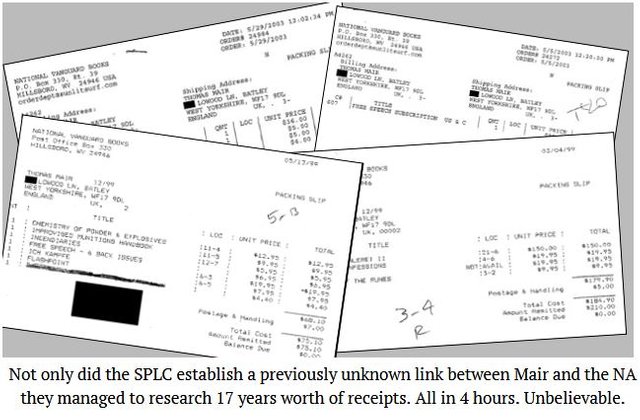
In just a few minutes the SPLC were able to search more than 17 years of NA records to locate receipts in Thomas Mair's name. Even more remarkable, they were able to identify the the broad , home made, form of the gun used in the attack, months before the UK police released any firm detail on the alleged weapon. They then collated the 'evidence, wrote and published their post allowing the UK MSM enough time to find, verify and then cite their article.
Any suggestion that the SPLC could possibly achieve all this in a few hours is untenable. It strongly suggests that a 'far right' narrative, in relation to Thomas Mair, was either created, or well known, before the alleged attack. It appears the article was ready to go as soon as Mair's name was released by the BBC.
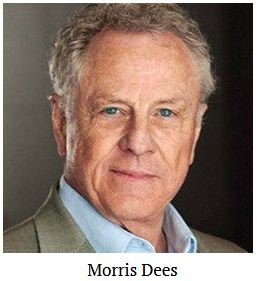
As the BBC were apparently lying about where they got their information it is not beyond the realm of possibility that they were involved. Perhaps they were compelled to release the name in order to facilitate the publication of the SPLC article? However, The BBC report did not leave anywhere near enough time, or provide sufficient information, to enable the SPLC to complete their breathtaking piece of research from scratch. Unless they, and others, already knew about Thomas Mair.
The SPLC has worked closely with the FBI for many years. Prior to the 1995 Oklahoma city bombing an SPLC activist, the lawyer and a founding member Morris Dees, was working with the FBI to provide intelligence from inside a far right training camp in Elohim City, Oklahoma. The SPLC's relationship with the U.S state has lasted more than 25 years. The FBI disavowed itself from listing the SPLC as a resource in 2014. However they admitted to still working with the group in 2018.
It appears the SPLC has been used as a private intelligence asset and propaganda outlet by elements withing the U.S state for decades. Whether they were working autonomously, or under direction, when they 'found' the evidence relating to Thomas Mair is unknown.
Part of the rapidly emerging Thomas Mair 'racist extremist' narrative was based upon an account from an American neo-nazi called Todd Blodgett. He stated that he had met Thomas Mair at a 'far right' rally in the UK in a story published on the 19th by the SPLC. Blodgett was a well know FBI informant which, given their relationship with the SPLC, is notable.
Blodgett stated that he flew to the UK in 2000 for a meeting arranged by the NA with leading far right activists in the UK. He claimed Thomas Mair was among them. Openly admitting his role with the FBI, Blodgett stated he was part of an FBI / IRS Joint Terrorism Task Force (JTTF). Upon his arrival in the UK, he claimed he and the rest of the JTTF entourage met with two MI5 operatives who gave him a secure phone to use.
As an informant, his role would have been to report the events at the meeting back to intelligence operatives. Yet the UK intelligence services apparently knew nothing about Thomas Mair, prior to his alleged attack upon Jo Cox. In the aftermath of the attack the police stated they had to investigate Mair's possible links with far right groups. If Blodgett's account is truthful, these would have already been known.
Two possibilities emerge. If the SPLC already had genuine cause to believe Thomas Mair was a member of far right organisations with links to the U.S, this would explain how they were able to investigate his alleged association to the 'National Alliance' on the day of the attack. Perhaps they had already catalogued the evidence pertaining to Thomas Mair and could simply pull up the information from their database. If this is the case, then Thomas Mair was well known to the FBI and MI5. Which means he would be yet another 'extremist,' known to intelligence, who went on to commit murder. It would also suggest the police weren't truthful when they stated they were 'investigating' his links to 'far right' groups.
However, there is significant doubt over Blodgett's account of the alleged encounter with Mair. One of Blodgett's far right colleagues Mark Cotterill, who knew many who attended the same meeting, which he states took place in 1998, flatly denied Blodgett's story. Cotterill, and his other white supremacist chums stated they had never heard of Thomas Mair. Seeing as British intelligence also said they knew nothing about Mair, Blodgett's claim of a meeting him seems extremely unlikely. This lack of plausibility is further supported by everyone who knew Thomas Mair, none of whom thought him a 'far right' extremist.
As discussed, there is no possibility at all that the SPLC knew nothing about Thomas Mair before 10.30 (U.S time) on the day of the attack. Had they not, they would have had no way of knowing about any links to the 'NA,' and wouldn't have known where to start looking for information. Therefore, if Blodgett's account was false, Thomas Mair was the target of disinformation campaign which began before the attack in Birstall occurred. If so, there is sound reason to suspect that the FBI, at the very least, knew about the existence of this planned propaganda. It was apparently released as soon as the BBC mentioned his name.
Read Part 2 to discover why Thomas Mair's was perhaps the most bizarre in British legal history.
Take it easy you hoopy froods.
